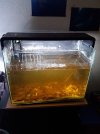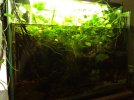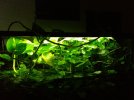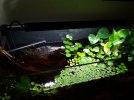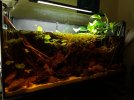ARK93
Member
- Messages
- 39
- Location
- East Yorkshire - England - UK
Hello,
I'm preparing to dive back into fishkeeping after a long hiatus. I previously kept a pair of A. macmasteri who showed frequent courtship behaviour but never raised eggs successfully. At the time my tap water contained nitrates of at least 50 ppm and gH was around 15, pH was somewhere in the region of 7.5. I eventually resorted to mixing the tapwater 50:50 with RO to get around these issues but I didn't dare go further down the RO route as all of the tank occupants were commercially bred and I often transferred juvenile fish between the tank and the aquatics store where I worked which also used pure tapwater for most species.
This time around I'd love to keep some more delicate blackwater species and hope to achieve breeding success with blackwater Apisto species and Chocolate Gouramis (in seperate tanks of course). Any advice regarding this issue would be greatly appreciated. I am currently looking at the following options, both of these would involve the use of high numbers of leaf litter, wood and floating plants. Please wade in with any criticism, corrections or general comments:
Option 1: Pure RO / rainwater. As I plan on lightly stocking the tanks (an Apisto pair/trio with a group of small dithers e.g. nannostomus sp. or smaller SA tetra species) I believe this will be a sustainable option. Depending on the species I would presumably have to remineralise the water to differing extents? If remineralisation is necessary what products do people recommend for this purpose? Alternatively I've seen references to people using "pure RO" although I currently don't understand what prevents a pH crash the moment acidifying substances such as peat, bogwood, leaves etc are added. I have a chemistry degree so this is especially embarrassing, please put me out of my misery in this regard!
Option 2: Mixing tapwater and RO / rainwater. Given the high nitrates and hardness in my local tapwater this would presumably require the use of several parts RO to one part tapwater. Unfortunately I don't remember, or never tested the kH of my tapwater last time around, but reducing the nitrates alone to an acceptable level would require a rather high level of dilution.
So, given the information I have provided about my water and willingness to purchase/produce RO water. What method would people use to obtain soft, fairly acidic water for keeping and breeding blackwater species? If mineralisation is required what do people recommend? Is there anything else I should be aware of?
I apologise for the slightly rambling nature of my post and thank anyone who takes the time to read it and respond!
I'm preparing to dive back into fishkeeping after a long hiatus. I previously kept a pair of A. macmasteri who showed frequent courtship behaviour but never raised eggs successfully. At the time my tap water contained nitrates of at least 50 ppm and gH was around 15, pH was somewhere in the region of 7.5. I eventually resorted to mixing the tapwater 50:50 with RO to get around these issues but I didn't dare go further down the RO route as all of the tank occupants were commercially bred and I often transferred juvenile fish between the tank and the aquatics store where I worked which also used pure tapwater for most species.
This time around I'd love to keep some more delicate blackwater species and hope to achieve breeding success with blackwater Apisto species and Chocolate Gouramis (in seperate tanks of course). Any advice regarding this issue would be greatly appreciated. I am currently looking at the following options, both of these would involve the use of high numbers of leaf litter, wood and floating plants. Please wade in with any criticism, corrections or general comments:
Option 1: Pure RO / rainwater. As I plan on lightly stocking the tanks (an Apisto pair/trio with a group of small dithers e.g. nannostomus sp. or smaller SA tetra species) I believe this will be a sustainable option. Depending on the species I would presumably have to remineralise the water to differing extents? If remineralisation is necessary what products do people recommend for this purpose? Alternatively I've seen references to people using "pure RO" although I currently don't understand what prevents a pH crash the moment acidifying substances such as peat, bogwood, leaves etc are added. I have a chemistry degree so this is especially embarrassing, please put me out of my misery in this regard!
Option 2: Mixing tapwater and RO / rainwater. Given the high nitrates and hardness in my local tapwater this would presumably require the use of several parts RO to one part tapwater. Unfortunately I don't remember, or never tested the kH of my tapwater last time around, but reducing the nitrates alone to an acceptable level would require a rather high level of dilution.
So, given the information I have provided about my water and willingness to purchase/produce RO water. What method would people use to obtain soft, fairly acidic water for keeping and breeding blackwater species? If mineralisation is required what do people recommend? Is there anything else I should be aware of?
I apologise for the slightly rambling nature of my post and thank anyone who takes the time to read it and respond!
